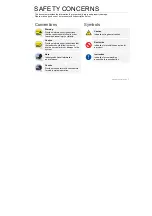
ENGLISH
39
WARNING:
To reduce the risk of
serious personal injury,
ALWAYS
hold
securely in anticipation of a sudden
reaction.
Proper hand position requires one hand under the
the housing, with the other hand on the main handle
(11).
Switching On and Off (fi g. A)
• To run the tool, press the variable speed switch
(1). The pressure exerted on the variable speed
switch determines the tool speed.
• To stop the tool, release the switch.
• To lock the tool in OFF-position, move the
forward/reverse slider (2) to the central position.
WARNING:
The drill is equipped with
a brake to stop the tool as soon as the
variable speed switch is fully released.
Drilling
WARNING: To reduce the risk
of serious personal injury, turn
tool off and disconnect tool from
power source before making any
adjustments or removing/installing
attachments or accessories.
WARNING:
To reduce the risk of
personal injury,
ALWAYS ensure
workpiece is anchored or clamped
firmly. If drilling thin material, use a wood
“back-up” block to prevent damage to
the material.
1. Use sharp drill bits only. For WOOD, use the
low speed setting and twist drill bits, spade bits,
power auger bits, or hole saws. For METAL, use
the low speed setting and steel twist drill bits or
hole saws.
2. Always apply pressure in a straight line with the
bit. Use enough pressure to keep drill biting, but
do not push hard enough to stall the motor or
deflect the bit.
3. Hold tool firmly with both hands to control the
twisting action of the drill.
CAUTION:
Drill may stall if overloaded
causing a sudden twist. Always expect
the stall. Grip the drill firmly to control
the twisting action and avoid injury.
4.
IF DRILL STALLS
, it is usually because
it is being overloaded or improperly used.
RELEASE TRIGGER IMMEDIATELY
, remove
drill bit from work, and determine cause of
stalling.
DO NOT CLICK TRIGGER ON
AND OFF IN AN ATTEMPT TO START A
STALLED DRILL — THIS CAN DAMAGE
THE DRILL
.
5. To minimize stalling or breaking through the
material, reduce pressure on drill and ease the
bit through the last fractional part of the hole.
6. Keep the motor running when pulling the bit
back out of a drilled hole. This will help prevent
jamming.
7. With variable speed drills there is no need to
center punch the point to be drilled. Use a
slow speed to start the hole and accelerate by
squeezing the trigger harder when the hole is
deep enough to drill without the bit skipping
out.
DRILLING IN METAL
Start drilling with slow speed and increase to full
power while applying firm pressure on the tool.
A smooth even flow of metal chips indicates the
proper drilling rate. Use a cutting lubricant when
drilling metals. The exceptions are cast iron and
brass which should be drilled dry.
NOTE:
Large [5/16" (8 mm) to 1/2" (13 mm)] holes
in steel can be made easier if a pilot hole [5/32"
(4 mm) to 3/16" (5 mm)] is drilled first.
DRILLING IN WOOD
Start drilling with slow speed and increase to full
power while applying firm pressure on the tool.
Holes in wood can be made with the same twist
drills used for metal. These bits may overheat unless
pulled out frequently to clear chips from the flutes.
Work that is apt to splinter should be backed up
with a block of wood.
MAINTENANCE
Your D
E
WALT power tool has been designed to
operate over a long period of time with a minimum
of maintenance. Continuous satisfactory operation
depends upon proper tool care and regular cleaning.
WARNING: To reduce the risk of
serious personal injury, turn tool off
and disconnect battery pack
before
making any adjustments or removing/
installing attachments or accessories.
An accidental start-up can cause injury.
The charger is not serviceable. There are no
serviceable parts inside the charger.
Содержание DW955
Страница 1: ...DW955 DW960 DW965 DW966 www eu ...
Страница 3: ...1 A 11 ...
Страница 4: ...2 B C ...
Страница 5: ...3 D E F 11 12 ...
Страница 177: ...175 ...
Страница 178: ...176 ...
Страница 179: ...177 ...
















































